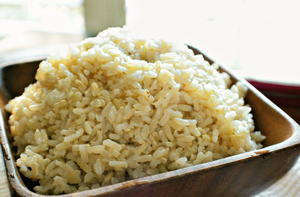Editor’s Note: If you are interested in learning how to make authentic sushi at home, start with this recipe for Sushi Rice. This Japanese sushi rice recipe includes a variety of tips for how to achieve the perfect rice for making sushi. Once you learn what sets sushi rice apart from regular rice, you will be well on your way to making restaurant-quality sushi. You will even learn how to make your own sushi vinegar using a combination of rice vinegar, sugar, and salt. This easy rice recipe includes instructions for both stovetop and rice cooker methods.
Makes9 cups (about 3 lb/1.5 kg), depending on how densely rice was packed
Ingredients
- 3 cups (20 oz/600 g) uncooked short grain rice
- 3-3 ¼ cups (24-27 fl oz/750-815 ml) water depending on age of rice and texture preference (see Tip number 6 below)
- Sushi vinegar:
- 8 tablespoons (3.5 fl oz/120 ml) rice vinegar
- 4 tablespoons sugar
- 1/2
teaspoon salt
Instructions
Put rice in a bowl, fill bowl with cold water and mix gently with hand. Drain and repeat 2-3 times until water is clear.
Leave rice under cold running water for a few minutes.
Drain well for 15-30 minutes or put rice and measured water in rice cooker or saucepan and let stand for 30 minutes.
To make sushi vinegar: Combine vinegar, sugar and salt, stirring well until sugar dissolves. Mixture can be gently heated to dissolve sugar and make the vinegar slightly milder. Set aside until required.
To cook rice in a rice cooker: Measure rice. After rinsing, put rice in rice cooker and add water to the required cup measurement marked on inside of bowl in rice cooker. Cover and switch to cook. When cooker switches to keep warm, let stand with lid on to complete the cooking process, about 10 minutes.
To cook the rice in a saucepan: In a medium saucepan bring rinsed rice and water to a boil. Reduce heat and simmer, covered, on low heat until all water is absorbed, 12-15 minutes.
Remove from heat and let stand with lid on to complete the cooking process, 10-15 minutes. Note: Rice can also be cooked in the microwave or steamed in a bamboo steamer.
Spread rice out in a large, preferably flat-bottomed, nonmetallic bowl or tub.
Using a rice paddle or wooded spoon, slice through rice at a 45 degree angle to break up any lumps, while slowly pouring sushi vinegar over rice to distribute evenly. You may not need all the vinegar.
Combine to slice, not stir (as it squashes the grains), lifting and turning the rice from the outside into the center.
Fan the rice so it cools to body temperature, turning it occasionally, 5-8 minutes. Cooling gives good flavor, texture and gloss to the rice. If rice becomes too cold, it hardens; do not refrigerate.
To stop rice from drying out, keep covered with damp cloth while making sushi,. Alternatively, keep in a nonstick surface rice cooker.
Tips for making perfect sushi rice
To successfully make sushi rice, choose short or medium grain rice; this has the right texture, taste and consistency to cling together without being too sticky when cooked.
A rice cooker is highly recommended as it produces perfect rice every time. The absorption method in a saucepan or microwave also works well, but avoid the rapid boil method.
Rinse rice 3-4 times before cooking to remove excess surface starch that could make the rice too sticky. Drain for 15 minutes.
Cool warm rice using an electric fan on lowest setting.
The standard rice cup provided with a rice cooker = 1 cup (5 oz/150 g) uncooked rice; 1 metric cup (8 oz/250 g) = about 1 ⅓ cups (7 oz/220 g) uncooked rice. Be sure to use the same cup to measure rice and water.
The texture of cooked rice is a matter of taste and varies with the age and storage conditions of uncooked rice. For a softer rice texture, cook the rice with a little more water. For a firmer texture, decrease the water amount.
Sushi rice is cooked with slightly less water than rice served as a side dish. It is slightly firmer and chewier than plain steamed rice.
Copyright 2004 Hideo Dekura, Brigid Treloar, Ryuichi Yoshii
YOUR RECENTLY VIEWED RECIPES
We are adding your Comments. ![]()
Thank you! Your comment has been added.
We are sorry. There was an error tyring to post your rating and review.
Your comment will appear after our editors have had a chance to review it.



